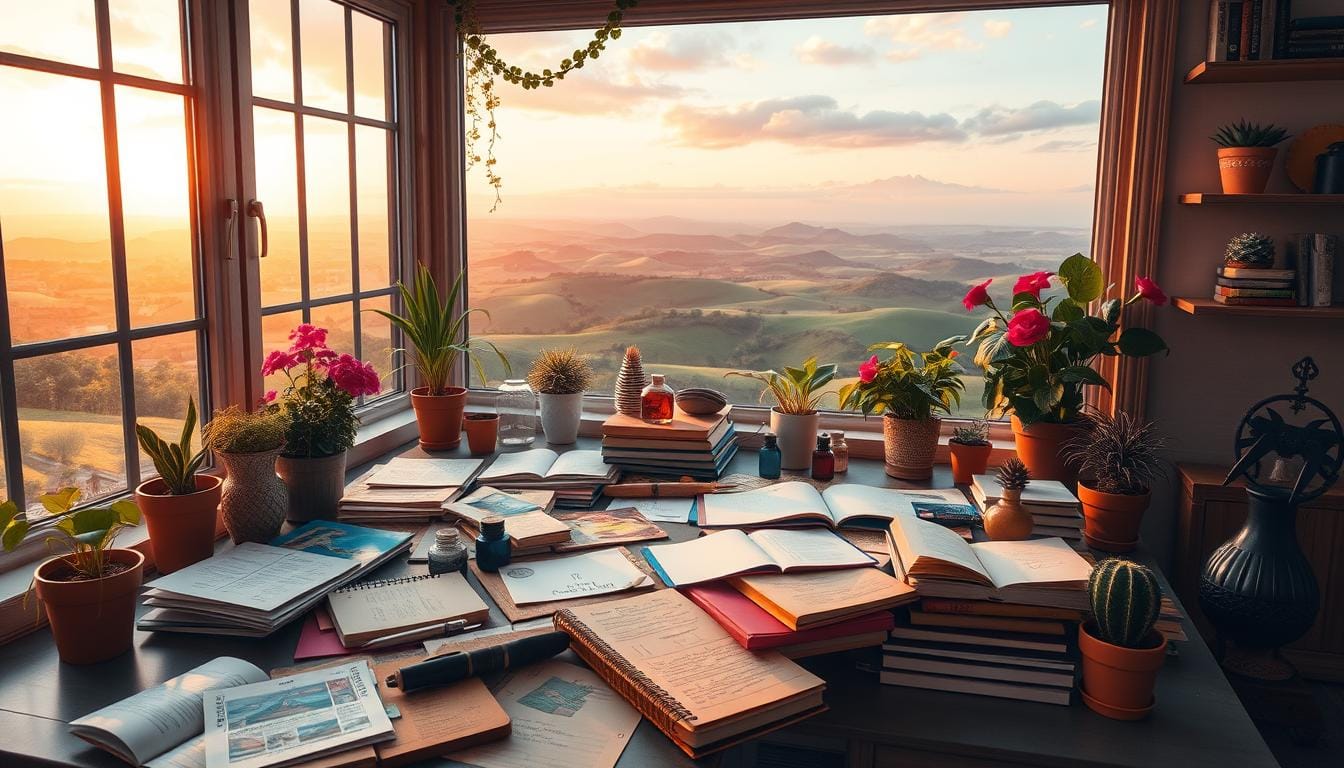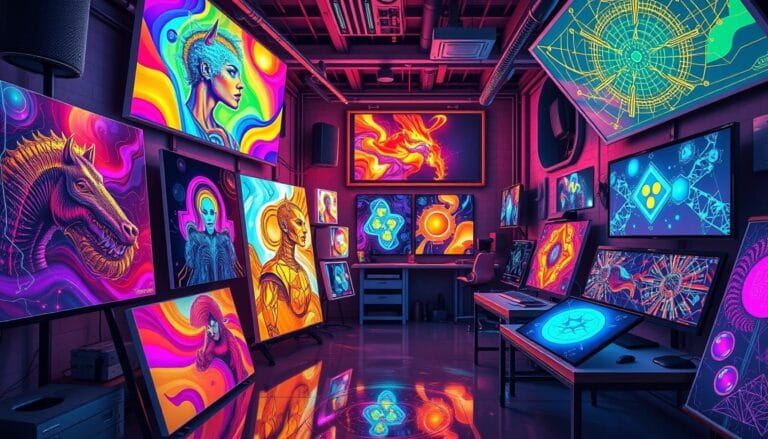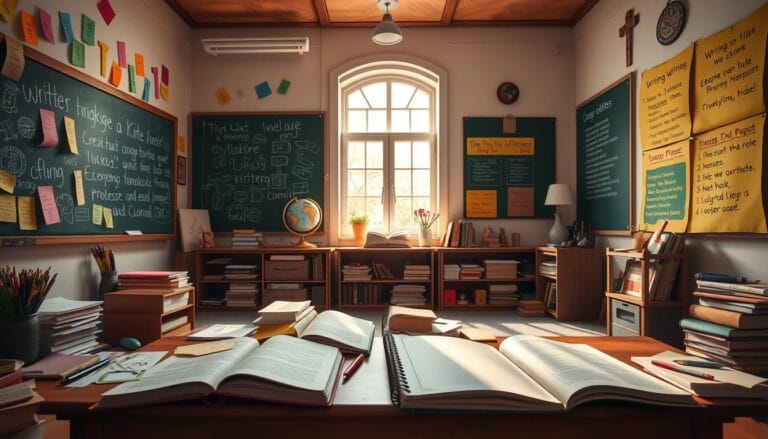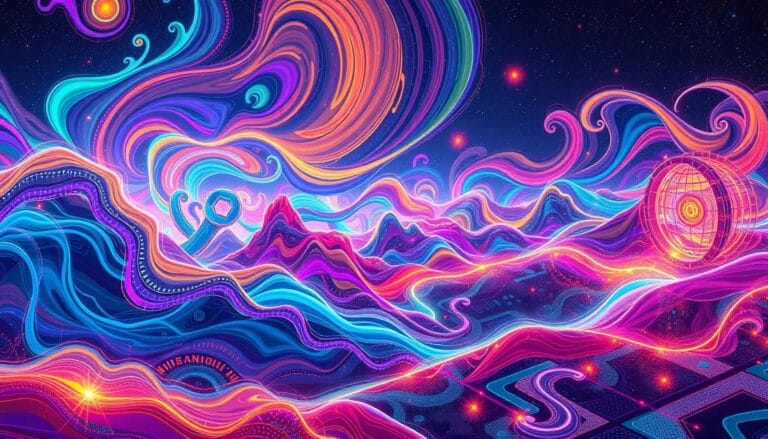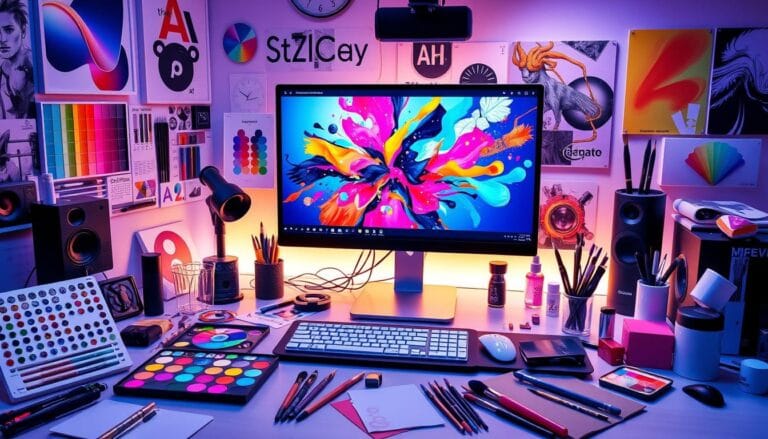Photos for Creative Writing: Inspiring Visual Prompts to Spark Creativity
Looking at a blank page can be scary, especially for young writers. But, what if a single photo could unlock your creativity? Visual writing prompts can spark imagination, helping students of all ages tell their stories.
Thank you for reading this post, don't forget to subscribe!As an educator, I’ve seen how these visual cues change things. A calm landscape, a playful animal, or a mysterious city can start a thousand stories. Photography’s power lets us help students break through writer’s block and find their creativity.
In this guide, we’ll dive into using photos for creative writing. We’ll look at why visuals inspire us and how to use them in class. From creating vivid characters to telling exciting stories, the world of imagery is full of possibilities.
Let’s start this journey together and see how photos can spark creativity in your students. By the end, you’ll know how to make your writing class a place of imagination and self-expression.
Table of Contents
Key Takeaways
- Photo-based writing prompts can inspire creativity and help students overcome writer’s block.
- Visual stimuli can trigger storytelling, character development, and imaginative writing in diverse classrooms.
- A collection of 70 unique photo prompts covering a range of themes is available for easy implementation.
- Utilizing photo prompts can engage students in individual writing exercises as well as collaborative group activities.
- Visual writing prompts can be adapted for both in-person and distance learning environments.
Understanding Visual Prompts in Creative Writing
Visual prompts are now a big hit in creative writing. They offer a new way to start writing, different from just using words. Images, photos, or objects can spark creativity in young writers. They help students practice writing skills like describing scenes, creating characters, and telling stories.
Benefits of Using Visual Stimuli
Images that suggest a story or raise questions are the best prompts. They can be used for warm-ups, independent work, or even when you’re not there. Visual prompts boost creativity and make writing more engaging and detailed.
How Images Trigger Storytelling
When students see a thought-provoking image, they start thinking of ideas and questions. They wonder about the scene, the characters, and the setting. These questions help them start a story and improve their storytelling skills.
The Psychology Behind Visual Inspiration
Looking at images makes students think deeply about what they see. This helps them understand the subject better. Visual prompts can inspire writing in many subjects, like science and social studies. They are especially good for English Language Learners and students of all ages.
Using visual prompts in your teaching can really engage your students. It helps them grow creatively and develop important writing skills. By using images, you can open up a world of stories and spark a love for writing in your students.
Photos for Creative Writing: Essential Elements
Quality, intrigue, and sparking imagination are key in picture prompts for story writing. Picture prompts for story writing should be high-quality and visually stunning. They should make you wonder about the story behind the photo.
Good picture prompts for story writing make you think about what happened before and after the photo. They hint at a larger story, encouraging writers to explore its depths.
Effective flux ai image generation prompt list should inspire creativity and lead to unique stories. These prompts should challenge writers to find the hidden meanings in the images.
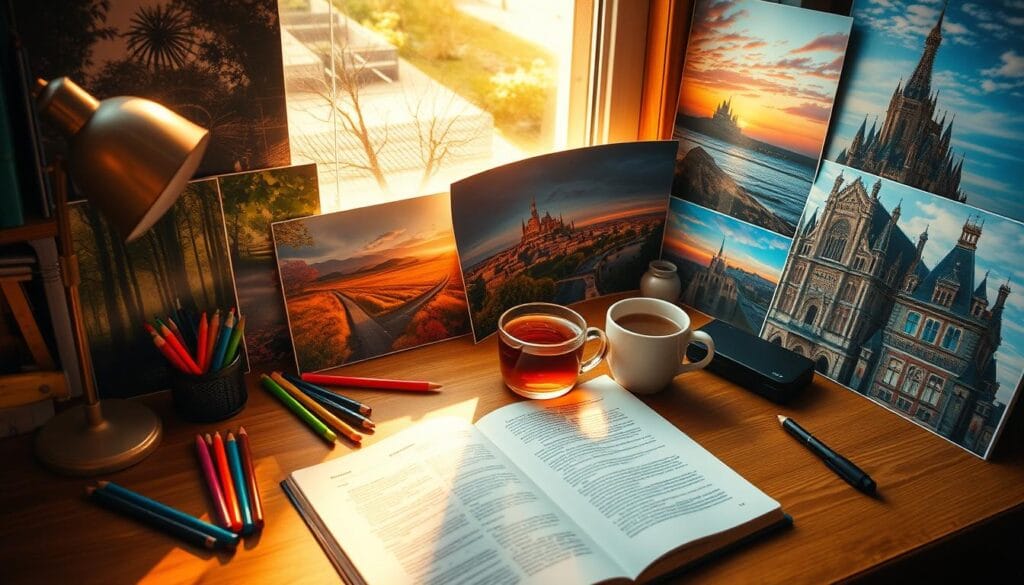
When picking or creating picture prompts for story writing, choose high-quality, striking images. These images should suggest a rich, untold story. This helps unlock writers’ creativity and fosters captivating narratives.
Selecting the Perfect Images for Story Generation
Finding the right visual inspiration is key to crafting captivating stories. Whether you’re a seasoned writer or just starting, using different types of images can be a great starting point. From landscapes to abstract art, each type can spark unique stories and characters. Let’s look at how to pick the perfect images to spark your storytelling.
Landscape Photography as Writing Prompts
Breathtaking landscape photos can take you on adventures and fill you with wonder. Use these images to describe settings, paint vivid scenes, or imagine journeys. They can inspire stories about the outdoors, survival, or exploring nature.
Portrait Images for Character Development
Portraits, of people or animals, can bring your characters to life. Study the expressions, body language, and details to learn about the subject’s personality and backstory. This can help shape your character’s look, motivations, and relationships.
Abstract Photos for Imaginative Writing
Abstract images, with their bold colors and shapes, can spark your imagination. They can lead to surreal, speculative, or experimental stories. Use them to explore dreams, the subconscious, or create unique, genre-bending tales.
When picking images for prompts, choose a variety of subjects and styles. Try landscapes, portraits, and abstracts to find new story ideas. Each type of image can open up different narrative possibilities.
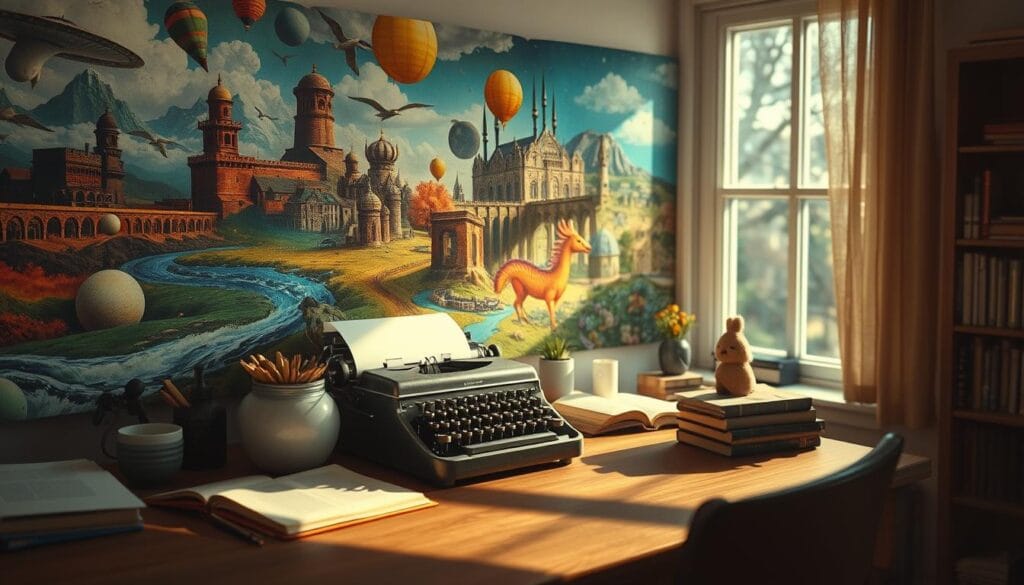
The secret to using images in your writing is to be open and curious. Let the visuals guide your creativity and explore new story paths. By embracing the visual world, you can take your writing to new levels.
Digital Resources for Finding Writing Prompt Images
In today’s digital world, finding great writing prompt images is easy. Sites like Pixabay, Unsplash, and Pexels have lots of free, high-quality images. You can search by subject, theme, or mood to find the perfect image for your writing.
What is an ai image prompt generator is also a big help. Tools like Midjourney, DALL-E, and Narrato’s AI Images make unique images from text. These image to prompt spaces can bring new ideas to your writing.
Social media like Pinterest and Instagram are also great for finding images. Follow accounts and use hashtags to find lots of visual prompts. They can spark your storytelling.
| Digital Resource | Description |
|---|---|
| Pixabay | A popular website offering a vast collection of high-quality, copyright-free images for use as writing prompts. |
| Unsplash | A platform featuring stunning, freely-usable photos that can serve as engaging visual prompts for your creative writing. |
| Pexels | A website with a diverse range of visuals, including landscapes, portraits, and abstract images, to inspire your writing. |
| AI Image Generators | Tools like Midjourney, DALL-E, and Narrato’s AI Images can generate unique and surreal images based on textual prompts. |
| Pinterest and Instagram | Social media platforms that offer curated collections of visually-inspiring images for writing prompts. |
Exploring these digital resources can open up a world of visual inspiration. It can make your creative writing better and help you come up with new ideas for your stories, poems, and narratives.
Implementing Visual Prompts in Writing Workshops
Photos can do more than just inspire individual writers. In workshops, they can spark creativity in everyone. They make writing fun and engaging, whether you’re working alone or with others.
Individual Writing Exercises
Students can pick a photo or get one from a teacher. This photo can start a story, help create characters, or even begin a whole new tale. By focusing on what the photo makes them feel, writers can unleash their creativity and write something truly unique.
Group Activities with Photo Prompts
Using photos in group work brings out different ideas and views. Everyone can add to a story, making it richer and more interesting. This way, students learn to think critically, understand others, and see the many sides of writing.
Distance Learning Applications
With online learning, using image prompts for creative writing is even more important. Teachers can share photos online, starting discussions on new story ideas. This helps everyone think creatively and explore their imagination together.
By using photos for creative writing in workshops, teachers can open up a world of creativity. It encourages teamwork, sparks imagination, and brings back the joy of writing.
| Product | Original Price | Current Price |
|---|---|---|
| Hypothetical Questions | Visual Writing Prompts | What would you do? Icebreakers | $9.00 | $6.50 |
| Full Year Visual Writing Prompts & Activities | Describing & Inferencing Photos | $14.95 | $8.95 |
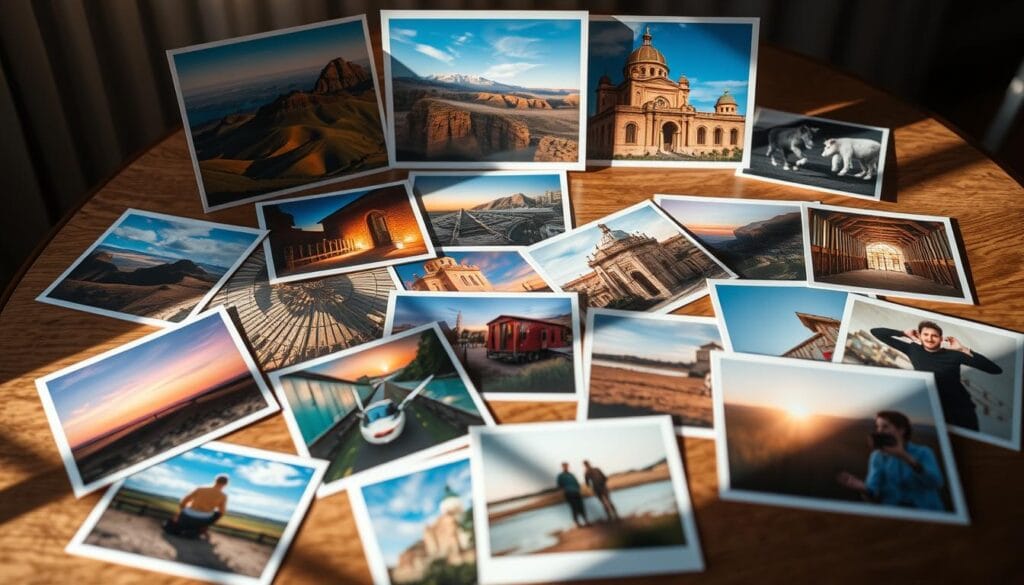
“A photograph can evoke multiple emotions and ideas with a single glance.”
As Roland Barthes said, photos can stir up thoughts and feelings. They can make us think deeply and personally. This helps writers create stories that are truly their own.
Creating Compelling Narratives from Single Images
Turning a single photo into a story can be magical. By asking students to look closely at an image, you spark their creativity. They start to think about the stories and viewpoints hidden in the photo.
Begin by showing your students a short story prompts with image or picture prompts for story writing. Ask them questions like “Who are the people in this photo?” or “What happened just before this photo was taken?”
- Look at the details: Tell students to study the photo carefully. Notice the arrangement, lighting, and any hints at the story.
- Think of backstories: Ask them to come up with unique stories for the people or events in the photo. Encourage them to think from different viewpoints and imagine different story paths.
- Consider different views: Ask students to imagine how the story might change if seen from another angle or through another character’s eyes.
Remember, there’s no such thing as a “wrong” answer here. The goal is to boost their creative writing skills and see the world in new ways. Using short story prompts with image and picture prompts for story writing, you can unlock your students’ full potential as writers.
| Type of Image | Storytelling Potential | Examples |
|---|---|---|
| Landscape Photography | Evoke a sense of place, atmosphere, and mood | Rugged mountain peaks, serene lakeside scenes, bustling city streets |
| Portrait Images | Reveal character, emotion, and personal narratives | Candid expressions, thoughtful gazes, or unexpected interactions |
| Abstract Photography | Spark imaginative interpretations and symbolic meanings | Patterns, textures, and shapes that evoke emotions or metaphorical associations |
Advanced Techniques for Photo-Based Storytelling
Writers can explore advanced techniques for visual storytelling. They can use photography to create compelling narratives. From setting development to plot construction, the possibilities are vast and captivating.
Setting Development Through Visuals
Photographs are powerful tools for setting development. By selecting and analyzing images, you can add details to your story’s environment. Use a series of photographs to unveil the setting, making it feel real to your readers.
Plot Construction Using Image Sequences
Arrange images in order to map out your story’s plot. Each photograph is a key moment or scene. Adjust the sequence to create a smooth narrative arc, from rising action to resolution.
Theme Exploration with Visual Elements
Explore themes in your story with visual elements. Choose images that resonate with your themes. Analyze each photograph’s symbolic and emotional value, weaving them into your narrative.
Photography can unlock new creative avenues for writers. It can enhance setting, plot, and theme exploration. Integrating visuals can elevate your writing and transport readers to new worlds.
Overcoming Writer’s Block with Visual Inspiration
Visual prompts can be great for writers stuck in a rut. They offer a real starting point, sparking new ideas and opening up the imagination. Writers should take time to really look at a photo, writing down what they see, think, and feel.
It’s not about copying the image exactly. It’s about using it to start their own stories.
Using photos for creative writing can help writers break free from old ideas. A beautiful landscape, a moving portrait, or an interesting abstract can spark new stories. Keeping a collection of image prompt generator writing can help writers get past creative blocks.
Visual prompts give writers a clear way to start their creative journey. They lead to new ideas and help beat writer’s block. By using these visual sparks, writers can find joy in storytelling again and explore new creative paths.
FAQ
What are the benefits of using visual stimuli for creative writing?
How do images trigger storytelling and inspire writers?
What makes a good visual prompt for creative writing?
What types of images can be used as effective writing prompts?
Where can I find high-quality images to use as writing prompts?
How can visual prompts be implemented in writing workshops?
How can students create compelling narratives from single images?
What are some advanced techniques for photo-based storytelling?
How can visual prompts help overcome writer’s block?
Source Links
- Creative Writing, you can search on Wikipedia: Creative Writing on WikipediaFor
- Writing Prompts, you can check: Writing Prompts on Wikipedia
- Artificial Intelligence, ArtWikipedia
- Midjourney, docs quick start

